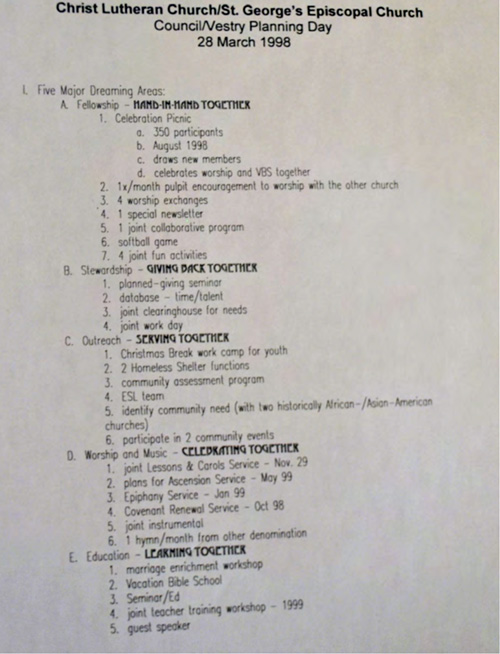The Archdiocese of Chicago‘s Office for Ecumenical and Interreligious Affairs defines “the difference between ecumenical, interfaith, and interreligious relations,” as follows:
- “ecumenical” as “relations and prayer with other Christians,”
- “interfaith” as “relations with members of the ‘Abrahamic faiths’(Jewish and Muslim traditions),” and
- “interreligious” as “relations with other religions, such as Hinduism and Buddhism.”
Here, we are looking at the first one, ecumenical.
The significant event was the Lutheran Episcopal Covenant of 1997.
A joint covenant committee between two local congregations was founded in 1995 on a Vestry motion by Pam Jewett-Bullock and Malana Smith. This came from a Lutheran Episcopal study group that recommended a committee between St. George’s and Christ Lutheran to “explore ways that our two congregations can grow towards and in full communion with each other.” It would be lay-led with clergy as ex officio looking at worship, education , fellowship, service and ministry. This was ahead of the actual vote by these faith bodies in 1997. The dialog on full communion had been in the works since 1969
The covenant was signed in October, 1997.

The formal agreement between the two faiths was 3 years ahead. “Called to Common Mission” was the document between the the Evangelical Lutheran Church in America (ELCA) and Episcopal Church , establishing full communion between them. It was ratified by the ELCA in 1999, the ECUSA in 2000, after the narrow failure of a previous agreement. Its principal author on the Episcopal side was the Rev. Canon J. Robert Wright.
Under the agreement, they recognize the validity of each other’s baptisms and ordinations. The agreement provided that the ELCA would accept the historical episcopate, something which became controversial in the ELCA.
Locally in June 1997 the two churches set up goals and planned a meeting in March 1998 to “develop a working plan to meet those goals”. The following document shows the dreams of the time from March, 1998:

In Oct., 1998 on the anniversary was a pastor exchange and fellowship dinner Oct. 10, 1998 at Christ Lutheran. In 1999, the Covenant Committee became a commission.
There were lofty goals but in reality the covenant generated the following – Christ Lutheran invited to Shrine Mont several years, joint Vestry council retreats 1997-1998, a fellowship dinner in Oct. 1998 on the year anniversary of the exchange, pulpit exchanges annually. Some groups such as the youth met together at least once.
By the end of the decade there were some hesitations. The two churches planned for the education commissions of both churches to meet and to encourage the other commissions to meet with their counterparts. That found opposition in the church. The minutes reflects some questioning where the covenant was leading. The minutes spoke like it was beginning to feel that we were “losing St. George’s by trying to include in everything. ” The goals were extensive and it was difficult to bring the the two churches with different cultures together to meet them.
Between 2006-2010 Dick Roth from St. George’s and Stan Buch from Christ Lutheran worked together on accessibility projects. Generally the total was project was between $1,000 and $1,500 which was split.
In 2008, The St. Georgian in the Oct. issue celebrated the accomplishments
• Covenant signed in 1996
• Annual pulpit exchange
• Study sessions on common heritage
• Shrine Mont Family Weekends
• Game night at Witzke’s
• Octoberfest at Christ Lutheran Church
• Tenth Anniversary Celebration of Covenant
• Three joint accessibility projects
• Trips:
Virginia Theological Seminary, Alexandria, Va
Washington National Cathedral
Historic Christ Church, Weems, VA
